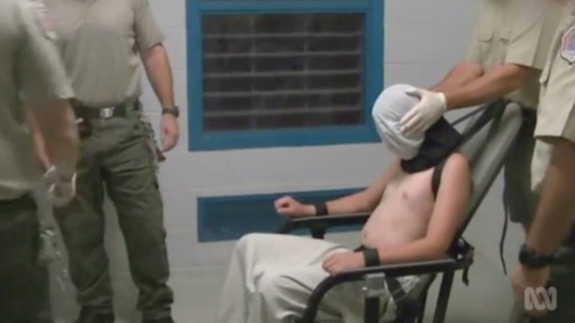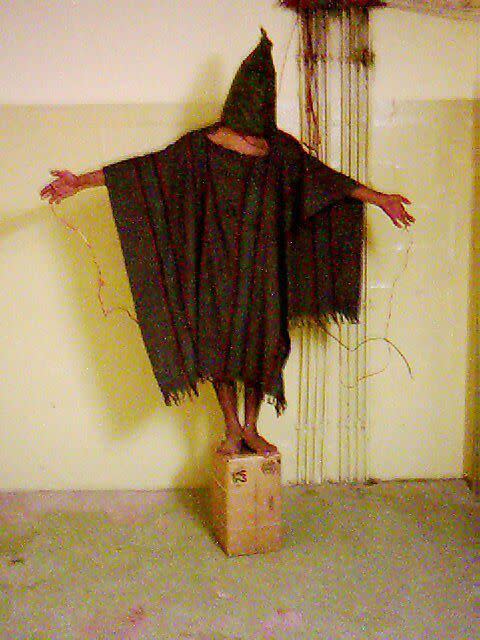How images like #DonDaleKids let us 'perform' our shock and outrage

His head hangs forward, enclosed in a white bag known in rough prison parlance as a "spit hood." His young chest exposed, two black straps tie his shoulders to the chair.
The harrowing image of then-17-year-old Dylan Voller, taken from the ABC's investigation into the 'torture' of young people at the Don Dale Youth Detention Centre in Darwin, Australia, is just one of many instances of abuse detailed in the news program aired Monday. But it is the one that was chosen to lead a myriad news stories, and the one destined to be imprinted on the national conscience.
SEE ALSO: Facebook takes down footage from child 'torture' report
It is the Voller image that has been most tweeted, posted and linked to in the days since the program. Is it possible that one of the reasons images like Voller's go viral is because they are a way for us to signal our innocence? To profess that we didn't know what was happening at Don Dale.
We display our horror, but perhaps the reason the image means so much is because we knew all along.
The historical resonance
When we share Voller's image on social media, we are shocked but we're also pantomiming shock.
Such images become iconic because they are linked to historic depictions of horror and cruelty, which we know implicitly should be disavowed publicly and social media provides the means.
As many have pointed out, there is a direct line of inheritance between the picture of Voller, hooded and tied to a chair, and the image of Ali Shallal al-Qaisi, the hooded man at Abu Ghraib.

Image: AP
Such images have the power to become an event, with their own strange weather and momentum, Suvendrini Perera, professor of cultural studies at Curtin University, told Mashable Australia.
To do so, they need to tie into a broader social imagining. "I think it has to have that historical resonance, it has to link to other images that are familiar in the culture, consciously or unconsciously," she said.
Such images – people tied and restrained – are part of a visual language of global terror, but there are also particular messages for Australians implicit in Voller's bound arms and legs. Aboriginal Australians are vastly overrepresented in Australian jails, and 97 percent of incarcerated youth in the Northern Territory are Indigenous.
To be Australian is to inherit a catalog of images of black men and women in chains.
Ann McGrath, professor of history and director of the Australian Centre for Indigenous History at the Australian National University, pointed out this link. "People instantly see this carceral history and the cruelty of people who had just been living out in the bush, [who] suddenly couldn't be any less free in these horrible restraints," she said.
For photos of this nature, people don't even need to know the story to create their own, she suggested. "I think people do think of Abu Ghraib, but then they think of the Northern Territory and they know the story of stolen children," she added. "This has reminded them of that longer history of cruelty."
Professor Perera agreed, but linked the images to the transnational nature of state and racial violence.
"Those images that we recall of Aboriginal people being shackled and manacled, those also link to histories of slavery in the U.S," she said. "The way that colonial violence was practiced and performed on Indigenous and non-white bodies."
We say we don't know, but we do
Voller's image has gone viral because it lets us participate in a rejection of this reality, which, of course, we should have been doing all along.
"Our society functions on us not knowing and not seeing, and our being constantly able to say, ‘we didn't know,’ " Perera said, "but in fact we do know.
"It's almost an exaggerated horror. I understand that people are generally horrified, but as Tony Birch has said, the novelist and historian, it's a stain on our nation that so many people say they're shocked, or are shocked, because we should not be shocked."
This performance is not reserved for civilians, however.
The government is also being allowed to perform outrage over Voller's image. The tape had barely finished rolling before Prime Minister Malcolm Turnbull called for a Royal Commission into juvenile detention in the Northern Territory.
One can tell this is simply performance because Turnbull has so far declined to expand the commission's remit to other states, which could surely provide photos to match Voller's treatment. And because the Northern Territory government will be involved in the joint inquiry.
This is the same Northern Territory government that voted for guards to be able to use mechanical restraints on children like Voller.
Performance can activate real change, however. Images bear witness, but they can also translate into new movements.
Take the Black Lives Matter movement in the U.S. People witnessed the video of Philando Castile dying next to his girlfriend in a live Facebook video and took their bodies to the streets in protest.
"People have been taking those images to the public space and actually acting out the photographs: People doing 'hands up don't shoot,' the 'die-ins,'" Perera added. "It's part of the power of the Black Lives Matter movement that there are people keeping them alive in action.
SEE ALSO: 'Torture' of kids in detention shows why we need a #BlackLivesMatter conversation in Australia
"It's really how we follow up, how we keep those images alive, how we keep those sensations alive."
If not, we can only wait for the next outraging image to flood social media — one that will remind us, dimly, of something we saw in 2016: Dylan Voller, tied to that chair.
Rallies drawing attention to the incarceration and treatment of Indigenous youth in detention are currently being planned in all capital cities around Australia. See Facebook for details.
